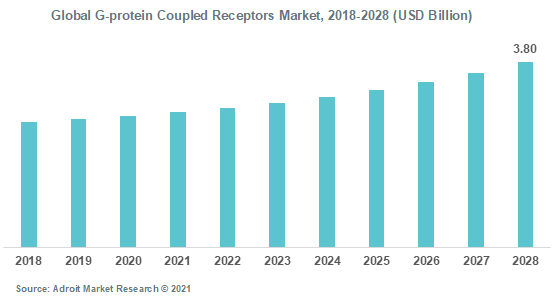The global G-protein coupled receptors market is projected to reach USD 3.80 billion by 2028, growing at a CAGR of 6.3%. The effective identification of pharmaceutically relevant drug candidates, the growing government funding for R&D activities in drug discovery and development and increasing prevalence of chronic diseases is driving the global G-protein coupled receptors market.

Adroit Market Research report on global G-protein coupled receptors market gives a holistic view of the market from 2018 to 2028, which includes factors such as market drivers, restraints, opportunities and challenges. The market has been studied for historic years from 2018 to 2019, with the base year of estimation as 2020 and forecast from 2021 to 2028. The report covers the current status and future traits of the market at global as well as country level. In addition, the study also assesses the key players based on their product portfolio, geographic footprint, strategic initiatives and overall revenue. Prominent players operating in the global G-protein coupled receptors market have been studied in detail.
G-protein-coupled receptors (GPCRs) or seven trans membrane domain receptors comprise the largest superfamily of proteins in the body. In vertebrates, this family contains 1000–2000 members including more than 1000 coding for odorant and pheromone receptors. The chemical diversity among the endogenous ligands is exceptional, they include biogenic amines, peptides, glycoproteins, lipids, nucleotides and ions. Moreover, the sensation of exogenous stimuli, such as light, odors, and taste, is mediated via this class of receptors
The global G-protein coupled receptors market is categorized based on assay type and application. On the basis of assay type, the market is segmented into calcium level detection assays, radioligand binding and GTPγS functional assays, cAMP assays and cGMP assays, β-arrestin functional assays, reporter gene assays and other assay types. The cAMP assays and cGMP assays segment dominated the market in 2020.
North America dominated the market for G-protein coupled receptors in 2020, while Asia Pacific is anticipated to grow at a highest CAGR owing to increasing government investment in the biotechnology and biopharmaceutical sector. Key players of the global G-protein coupled receptors market include Thermo Fisher Scientific, Inc., QIAGEN, Eurofins Scientific, WuXi AppTec, Abcam plc, Promega Corporation, Perkin Elmer Inc., Merck KGaA, Enzo Biochem Inc., Becton-Dickinson and Company among others.
Key segments of the global G-protein coupled receptors market
Assay Type Overview, 2018-2028 (USD Billion)
- Calcium Level Detection Assays
- Radioligand Binding and GTPγS Functional Assays
- cAMP Assays and cGMP Assays
- β-Arrestin Functional Assays
- Reporter Gene Assays
- Other Assay Types
Application Overview, 2018-2028 (USD Billion)
- Cardiovascular System
- Central Nervous System
- Oncology
- Other Applications
Regional Overview, 2018-2028 (USD Billion)
- North America
- U.S.
- Canada
- Europe
- Germany
- United Kingdom
- France
- Asia Pacific
- China
- Japan
- India
- Latin America
- Brazil
- Mexico
- Middle East & Africa
- GCC
- South Africa


